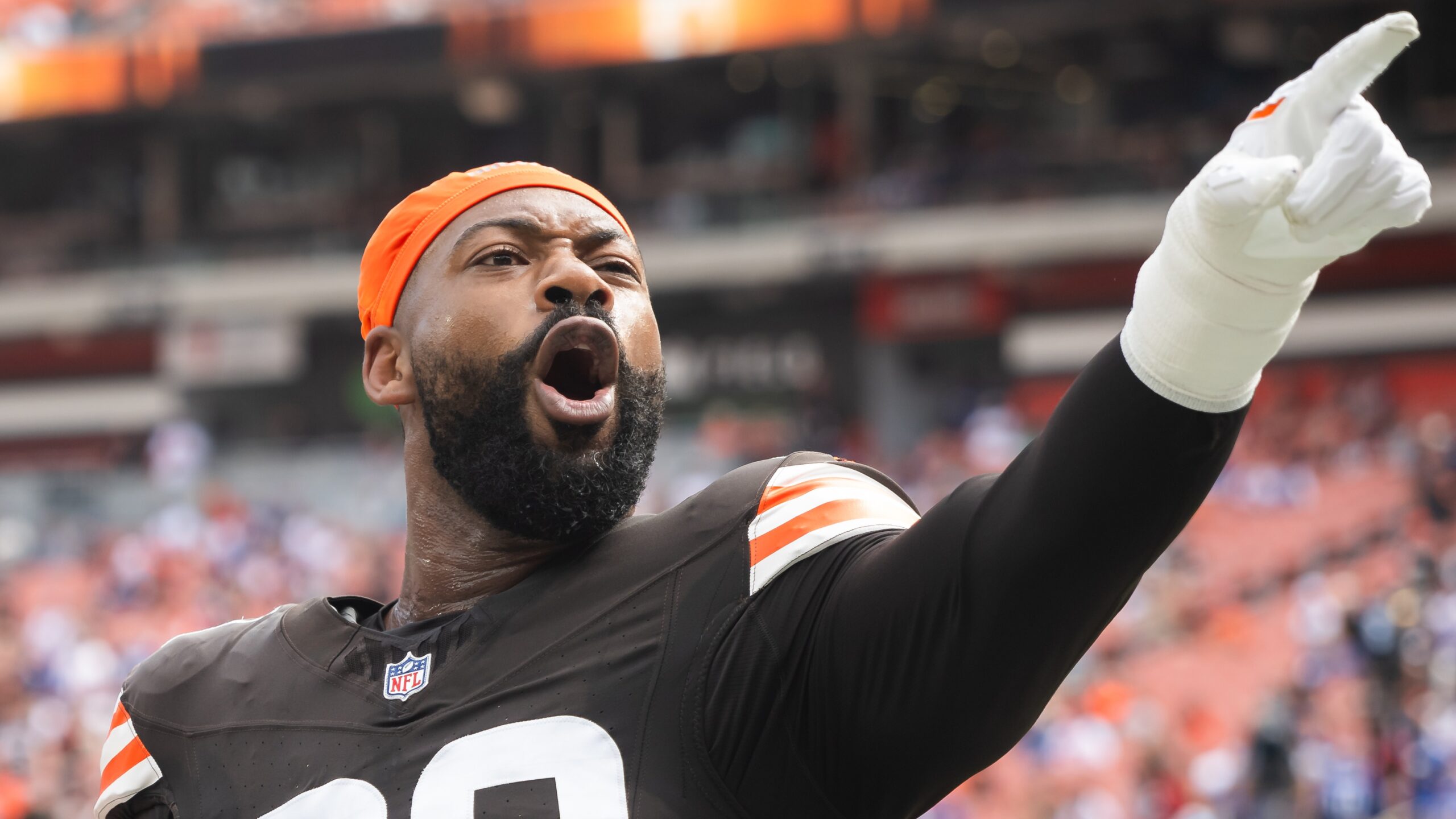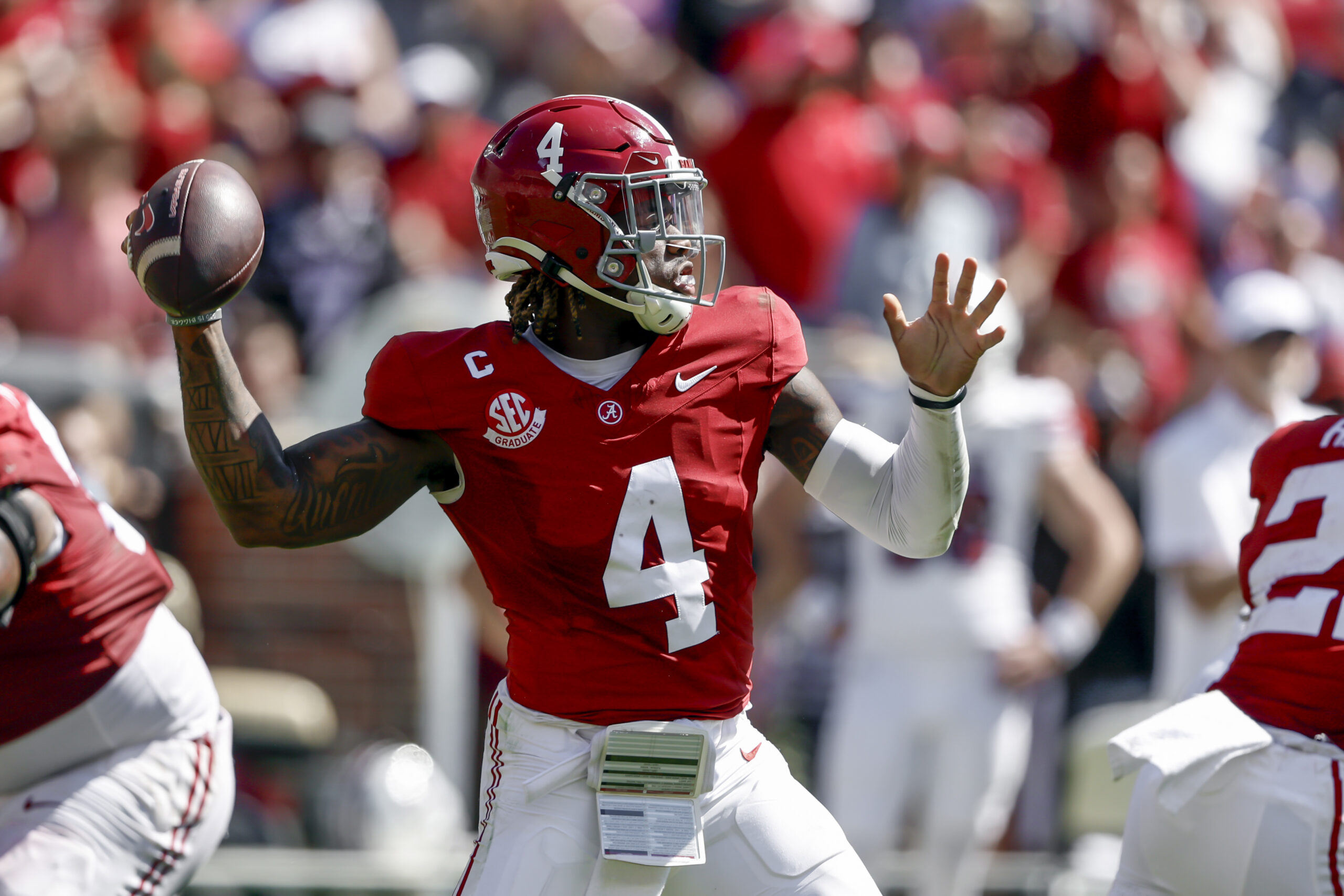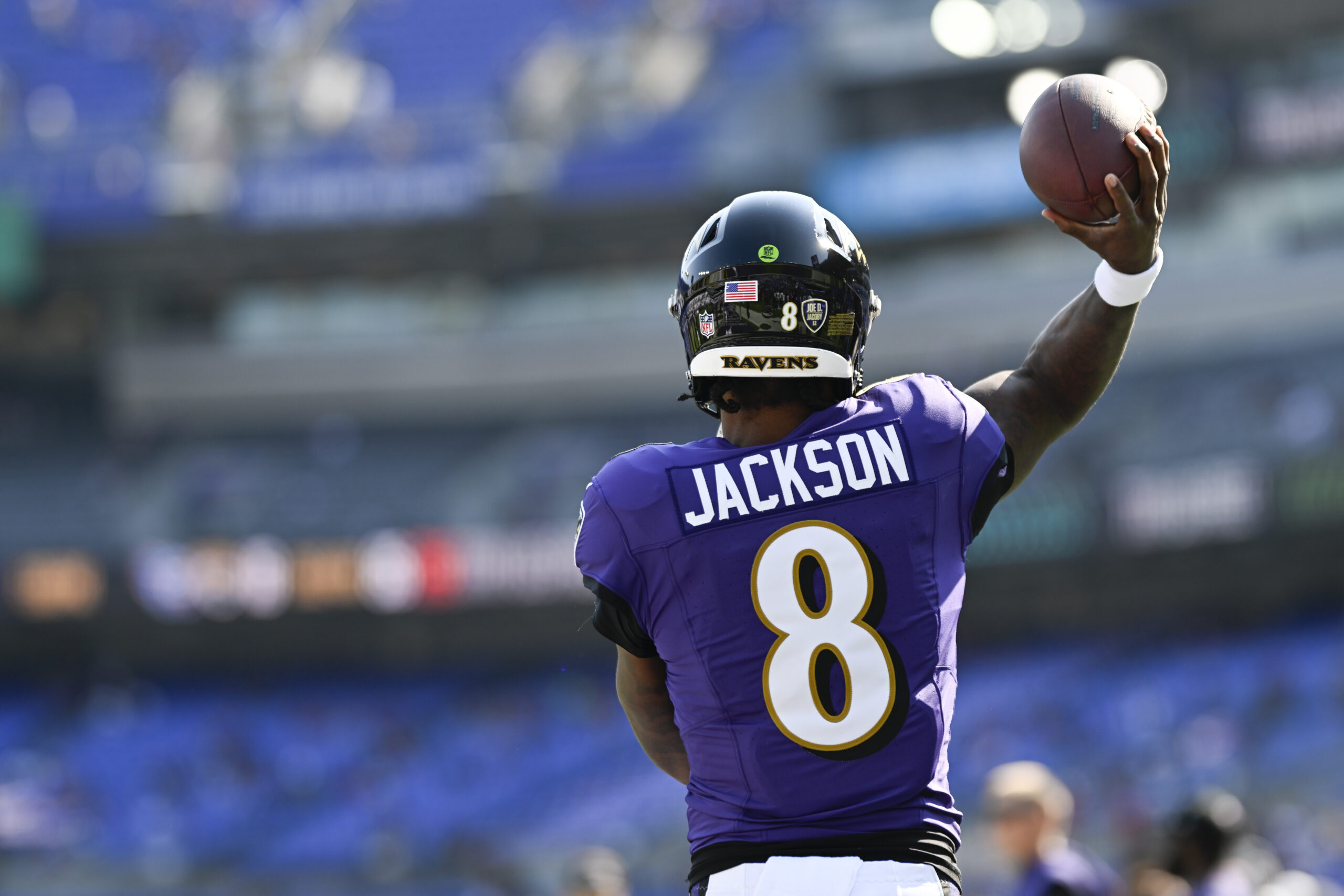NFL Analysis
10/14/24
22 min read
1st & 10 Week 6: Lions Win & Lose, Ravens Roll, Caleb Williams Keeps Getting Better & More
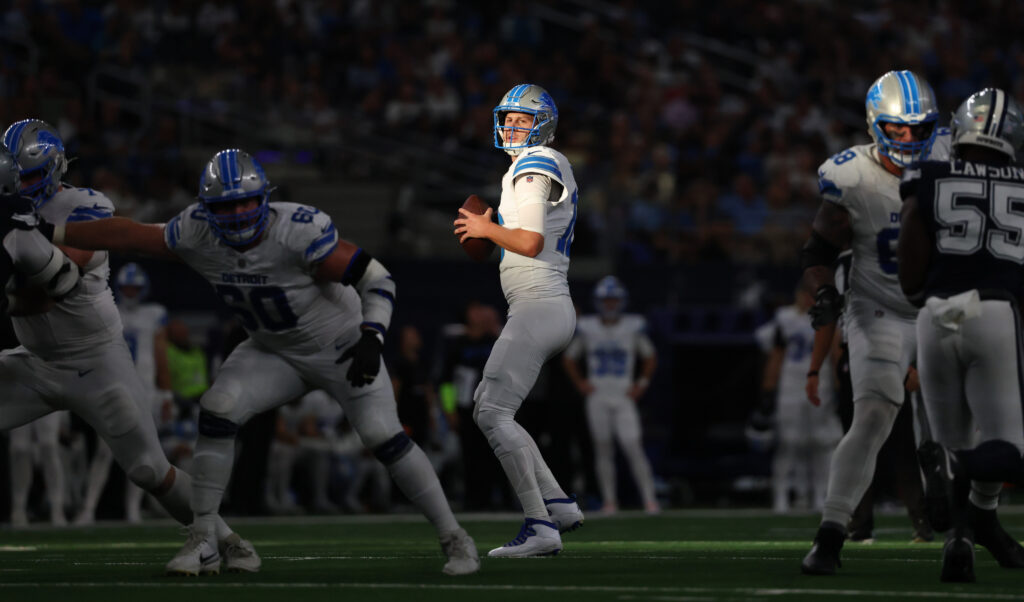
We’ve had some long days of football with back-to-back weeks with a London game, and there's still one more on the way in Week 7. At least this week, we didn’t have a Sunday Night Football game push early into Monday morning on the East Coast. But it did feature the New York Giants in primetime, so what’s really better?
Let’s digest another long day of football with what feels like an equally long article breaking it all down.
Each week, 1st & 10 will bring you a Monday morning in-depth breakdown of everything you need to know from Sunday’s slate of games. We’ll fill this column with stats, film, and plenty of words to keep you covered on anything you might have missed or want to dive deeper into from Sunday.
All stats provided by TruMedia unless noted otherwise
1st & 10 NFL Week 6
1. Lions' Offense Must Lead With Hutch Down
On the day of their most dominating win, the Detroit Lions suffered their most devastating loss. Late in a 47-6 win against the Dallas Cowboys, edge rusher Aidan Hutchinson went down with what looked like a significant injury. It was later diagnosed as a broken tibia. Hutchinson had immediate surgery to repair the break in Dallas and will miss the rest of the season.
Outside of a top quarterback, there might not be a more severe loss for a unit. Hutchinson leads the league in nearly every pass rush category: total pressures, pressure rate, sacks, quarterback hits, and early-down pressure rate. When thinking about the counting stats like hits, pressures, and sacks, keep in mind the Lions already had a bye.
Losing that caliber of player would be a hit to any defense, but those numbers alone don’t account for how much of the pass-rush production Hutchinson accounted for on the Detroit defense.
Through Week 6, Hutchinson accounted for 55 percent of the Lions’ total pressures. That’s easily the highest rate in the league. Nick Bosa is second at 42.9 percent. Last season, Maxx Crosby led the league at 41.2 percent, while Hutchinson finished the season fourth at 37.1 percent.
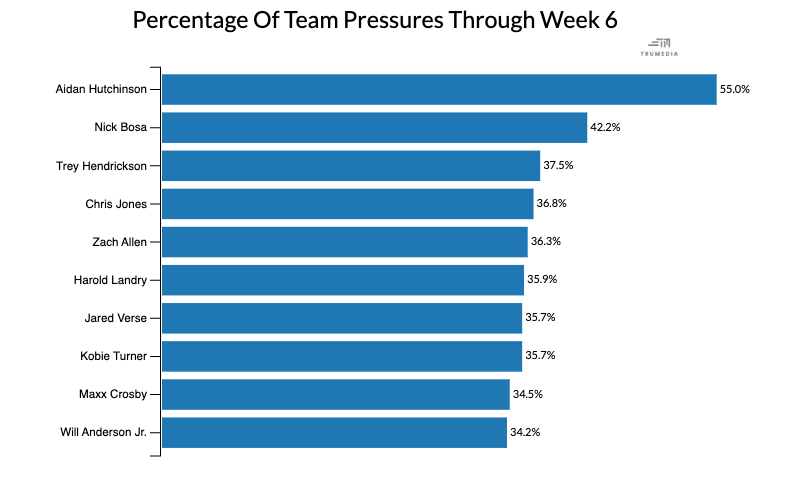
Before his injury against Dallas, Hutchinson had four pressures, three hits, and a sack. He also had a pass rush win rate of 42 percent, according to ESPN Analytics. So much of the Lions' defense depends on Hutchinson's ability to create pressure.
This comes a few weeks after the Lions lost No. 2 edge rusher Marcus Davenport. It might not be out of the question for general manager Brad Holmes to make a move to bring someone in before the trade deadline on November 5.
Without Hutchinson, there will be a huge shift in how this Detroit defense is constructed. If there is good news, it’s that the Lions just came off what might be their most complete defensive performance of the season. With 11 quarterback hits and 10 passes defensed, the Lions completed the second defensive double-double of the season after the Minnesota Vikings in Week 4 and just the eighth such game in the past five seasons.
According to Next Gen Stats, the Lions generated -31.3 EPA when playing man coverage against the Cowboys, the second-best game for a defense since 2018. Detroit has used one of the highest rates of man coverage (fifth through Week 5), and the young corners have gotten more comfortable holding up in man coverage at such a high rate.
It wasn’t just that the coverage was tight, it was how that worked to open up other things in the secondary. Dak Prescott only threw into a tight window on 15.2 percent of his throws, but he was forced into some uncomfortable throwing lanes.
On the first Brian Branch interception, CeeDee Lamb had snuck through to the corner of the end zone. However, Branch dropped back from his zone and picked off the pass.
On Dak's second interception, with the game out of hand, on a fourth-and-6, Prescott was forced to throw high over tight coverage, and Branch was behind the throw, ready to take advantage.
That coverage will be more important if the Lions return to heavy blitzing to create pressure without Hutchinson in the lineup. Alim McNeil had a great game and, after sacking Prescott twice, is now second on the team with 2.5 sacks. Levi Onwuzurike is second in pressures, so the interior could be where the Lions create pressure, but that’s a lot to put on that group.
While the defense figures itself out, there will be a big margin for error because the offense can’t stop scoring points.
Jared Goff went 18-of-25 for 315 yards and three touchdowns for a week-high 0.72 EPA per play. Despite leading for most of the game, the Lions stayed aggressive through the air. Goff threw 24 percent of his passes 20 or more air yards, the second-highest rate for his career. His 10.2-yard average depth of target was the ninth-highest of his career and the highest since joining the Lions.

Detroit created so many openings and explosive plays off a number of different looks. In the game, 30 percent of the Lions’ passing plays went for 16 or more yards. That was the third game of the season with at least a 30 percent explosive pass rate, after the Bears in Week 5 (30 percent) and the Cardinals in Week 2 (31.8 percent).
The Lions made a big play with a deep throw to Tim Patrick, which set up a short David Montgomery touchdown on the first drive.
Then, two drives later, the Lions created an open 57-yard touchdown to Sam LaPorta off a reverse flea-flicker.
The Lions have the talent and creativity to capitalize on these shot plays, which are becoming more prevalent in the offense. Later, a 37-yard touchdown to Jameson Williams came out of a trips bunch with Williams at the point.

Of course, the Lions also had the run game working against a Dallas defense that had allowed its opponents to run all over them. Montgomery and Jahmyr Gibbs split 24 carries for 143 yards.
Detroit is third in EPA per play on offense with the highest passing success rate. That was the result of the typical Lions offense, hitting in-breakers off play-action and moving the ball downfield with short, safe passes.
This explosive element is now real. The Lions are second in explosive pass rate after being 11th in 2023. They already have more pass plays of 50 yards through six weeks (four) than they did throughout last season (two).
That kind of offense might be necessary to compensate for any shortcomings the defense might have without Hutchinson leading it.
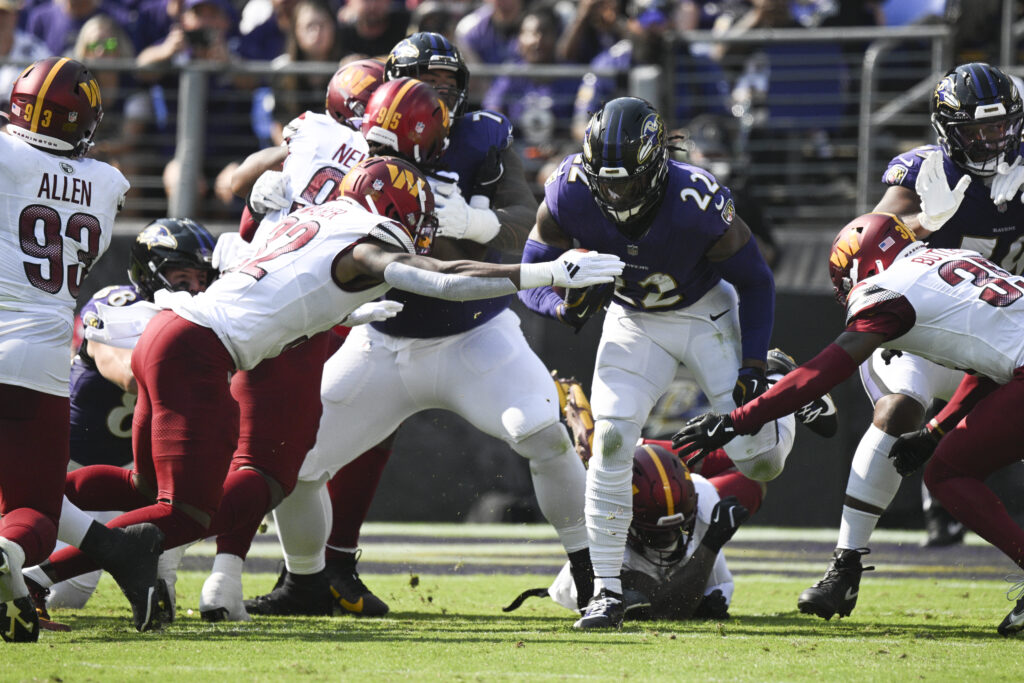
2. The Ravens Topped The Commanders
Ravens-Commanders would not have been expected to be one of the marquee matchups of any week this season, but there was plenty of intrigue going into this game. With Jayden Daniels, Washington had become one of the best and most consistent offenses in the league, while Baltimore was riding Lamar Jackson and Derrick Henry into one of the league’s best scoring units.
The Ravens got the upper hand in this matchup, winning 30-23, but both quarterbacks shined. Jackson averaged 12.4 yards per attempt while completing 20 of 26 passes.
Baltimore’s offense is now at a place where there is a potential to win in any way. Last week, the Bengals sold out to stop the run, and Jackson won with his arm and legs. This week, the Ravens had a fully formed passing offense that got the most out of some receivers who hadn’t got going yet this season.
Zay Flowers was targeted nine times and caught all nine for 132 yards. It started with a 44-yard screen on second-and-8.
BIG PLAY ZAY!!!! THAT’S A 44-YARD GAIN!!!
— Baltimore Ravens (@Ravens) October 13, 2024
TUNE IN ON CBS!! pic.twitter.com/2yBTg7peYq
But Flowers was more than just a run-and-catch player. He had a career-high 73 yards on in-breaking routes and 76 yards against man coverage, according to Next Gen Stats. Five of Flowers’s nine targets came off play-action, and Jackson went 12-of-13 for 239 yards off play-action in the game.
The offense continued to open up because on those play-action attempts, Jackson averaged an 11.2-yard aDOT and 1.17 EPA per play. His 18.4 yards per attempt were the second-best off play-action in his career.
Jackon continued to look comfortable in the pocket and finally had a connection with Mark Andrews, which included a 14-yard touchdown at the end of the second quarter.
Washington blitzed Jackson on 40 percent of his dropbacks, but he averaged 13.6 yards per attempt with one interception against an extra rusher.
There are continually more answers for the passing offense when needed, and Jackson still is a threat to run for a big play.
Washington just didn’t have the bodies to keep up with the Baltimore offense through the air or on the ground. Henry had 132 yards on the ground and was only stuffed on one of his runs despite running into a loaded box of eight or more defenders of 75 percent of his rushes.
The Ravens only used 11 personnel on 13.8 percent of their plays, the lowest in the league this week, and used heavier personnel of 12 (30.8 percent), 21 (21.5 percent), and 22 (23.1 percent). That kept Washington in base on 24.6 percent of their snaps after the Commanders had been a 90 percent nickel team with just one percent of plays in base in the first five weeks of the season.
Having the defense decide to focus on Henry opened up some of those in-breaking routes off play-action in the passing game, and the defense still couldn't do much against the running game. This is the dilemma the Baltimore offense puts on opposing defenses. Few defenses live in the heavy personnel needed to match up with the Ravens’ bigger bodies, but when defenses try, the offense can still either throw or pass regardless of who is on the field.
Baltimore is now second in EPA per play on offense and leads the league in yards per play (6.9).
The Washington offense still did what it could, and Jayden Daniels made some impressive throws to keep the Commanders in the game. Daniels's performance was inverse to last week's, when big plays made up for a lack of down-to-down success. However, against Baltimore, Daniels had a 50 percent success rate while he averaged 0.09 EPA per play, a season-low.
Still, there were plenty of wow throws, like the 4th-and-goal touchdown to Terry McLaurin in the fourth quarter.

3. Chicago is figuring it out on offense
Caleb Williams keeps getting better. We wrote about that in 1st & 10 last week and included a chart.
It’s time to update that chart.

Williams won't continue this linear progression, which would have him averaging nearly a point per dropback by the end of the season, but he’s clearly getting more comfortable and improving each week.
In a 35-16 win against the Jacksonville Jaguars in London, Williams had the best game of his rookie season. Williams averaged 0.50 EPA per play and had a 58.3 percent success rate. He only had a 4.0-yard aDOT, but Chicago's offense was well-designed to allow the quarterback to get into a rhythm.
The Bears have used a no-huddle offense as a weapon during the past two weeks. Chicago tried to use no-huddle to open the season because of how Williams played in college, but when things started to move a bit too fast for him, they slowed it down in Week 4.
After the success there, they’ve used no-huddle at their highest rates in Weeks 5 and 6.
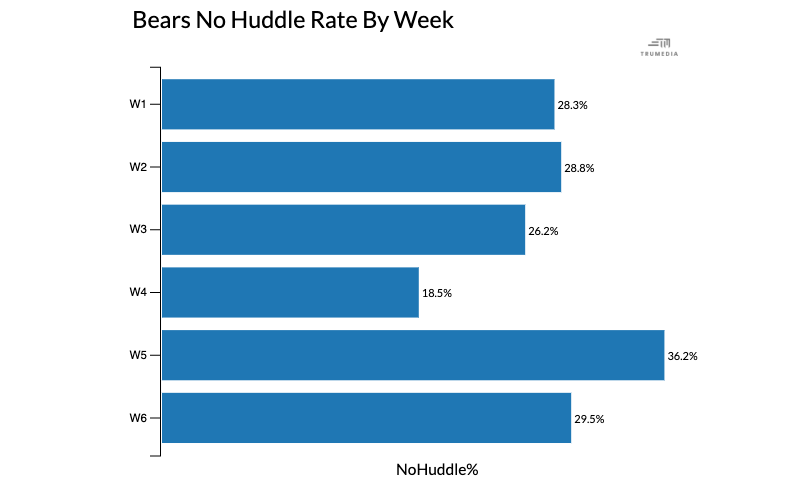
Against the Jaguars, Williams completed 5-of-6 passes with a scramble and a designed run on no-huddle plays. It’s clear Williams' game has slowed down a bit. He’s calmer in the pocket when the protection allows him to.
He had his best game as a quick passer in Week 6, going 13-of-14 for 111 yards and three touchdowns on throws under 2.5 seconds. He averaged 1.10 EPA per play with a 78.6 percent success rate after averaging 0.07 EPA per play with a 46 percent success rate on quick throws through Week 5.
When Williams can get into that rhythm, he’s made some incredible throws. His placement on the nine-yard touchdown to Keenan Allen might have been his best.
There are still things that can be worked on. Williams hasn’t completely mastered the deep pass yet, and he’s only completed 25.9 percent of his throws of 20 or more air yards this season. But that should improve. The fact that he’s still playing well while still having a weakness that should improve is a fairly good sign for his overall development.
Part of that improvement has been the overall feel of the offense. The offense's construction just looks better. Routes look like they have more purpose. D’Andre Swift has been put out in space, which has created some explosive plays. Thanks to some of the quick passing, the run game has been opened up overall. It’s a much-improved unit than what it looked like during the season's first three weeks.
In the past three weeks, the Bears are third in EPA per play on offense. Combined with a defense that is third in the league in takeaways per drive, the Bears have become a frisky team. That might be underselling their game. They’re the third-best team in the league by point differential (+47), though they’re also third in their division behind the Vikings (+63) and Lions (+60).
If Williams continues to play like he has, and the defense keeps its pace up, this won’t just be a flash.
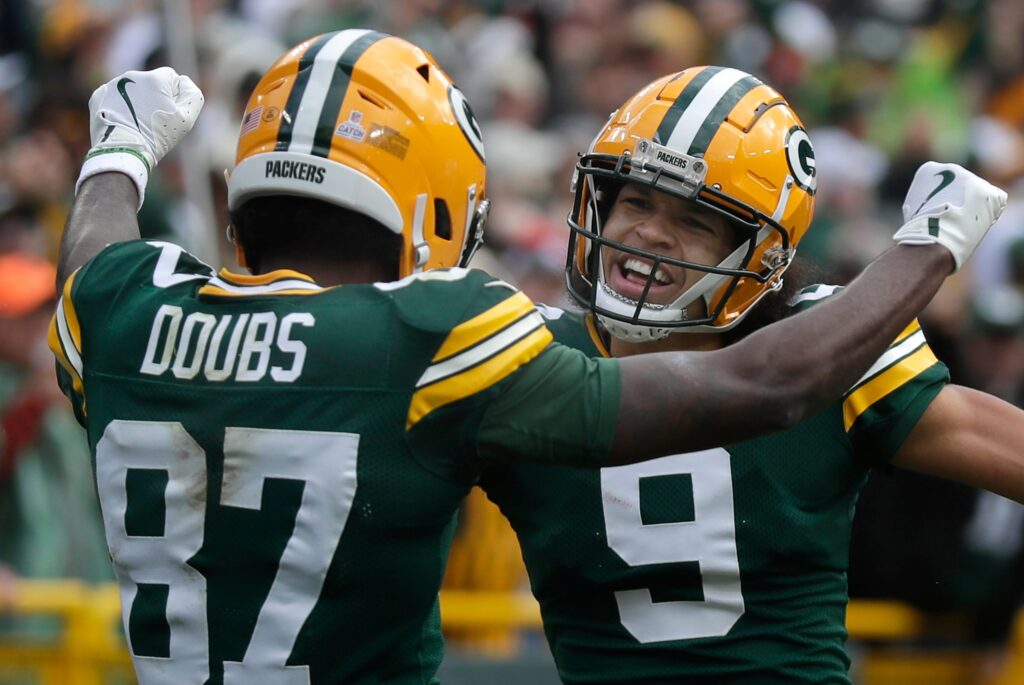
4. A Full display of Packers receiver depth
Last week, Romeo Doubs was upset about the game plan and his role in it, even though Christian Watson wasn't available. Doubs didn’t practice late in the week and was officially suspended for the game. Doubs and Watson returned this week, and the Green Bay Packers showed off how important having all of their receivers can be.
In a 34-13 win against the Arizona Cardinals, just about every Packers receiver had a moment. What makes the Packers so dangerous is that each receiver brings something different to the offense, and any of them can be targeted on a given play.
Jayden Reed is one of the league’s best slot receivers, and not just in a typical way. No slot receiver goes deep more than Reed, and the Packers have hit a number of big plays to him already this season — he’s in a six-way tie for the most receptions of 20 or more yards with eight.
He had a touchdown on a crosser from the slot on a third-and-goal in the first quarter.
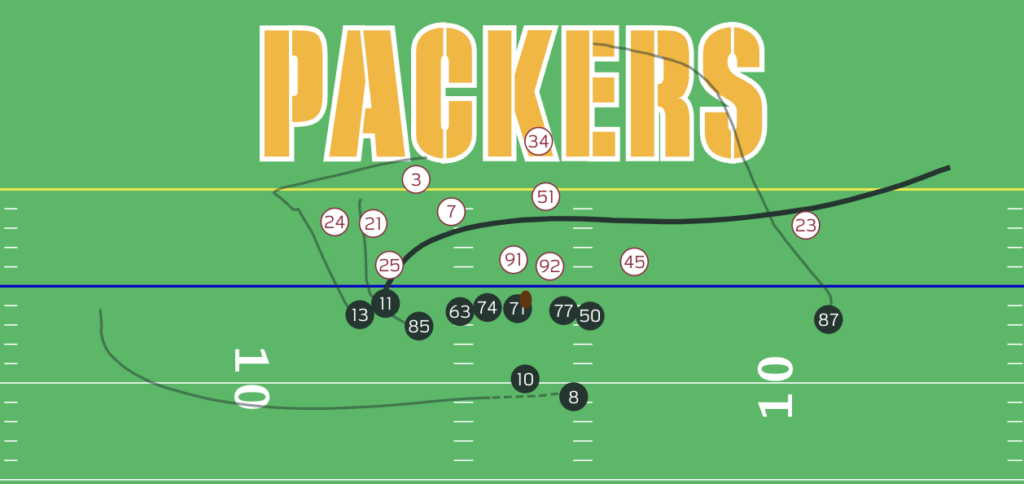
Doubs is typically the X receiver and doesn’t always get much volume, as he clears out deep safeties and opens up the middle of the field for the other receivers. Still, here returned with three catches for 49 yards and two touchdowns against Arizona.
His first touchdown came as the slot in a 3x1 set with tight end Tucker Kraft in close as the iso receiver on the left side.
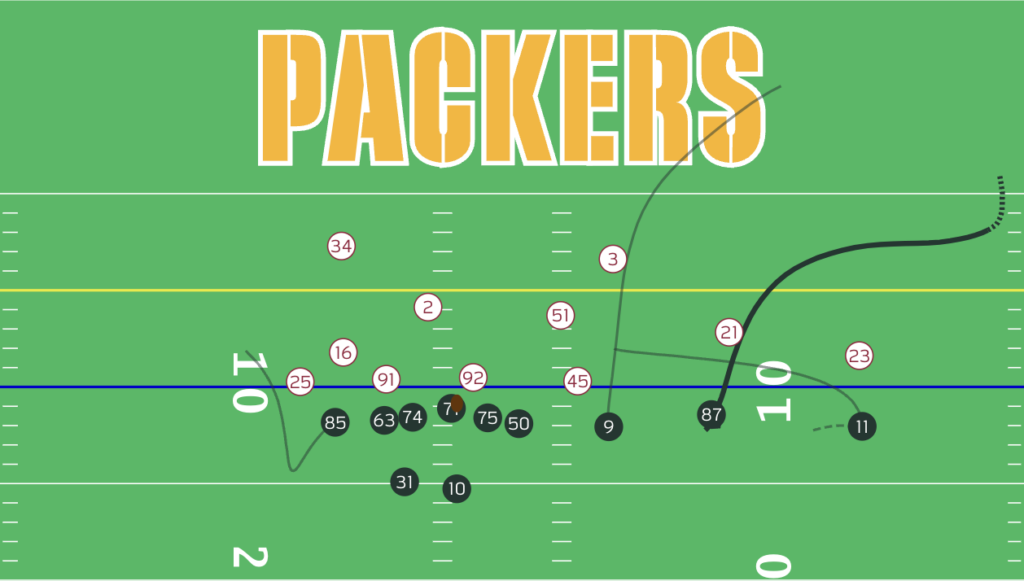
Watson is the deep threat, and the Packers got him open for a 44-yard touchdown by coming out in 12 personnel, getting the Cardinals into single high, and sending Watson matched up on safety Budda Baker.

Jordan Love is more than willing to throw to whoever is open… and even those who aren’t. Love will trust his receivers, as he did on Doubs’s second touchdown off an aggressive 0-blitz when Love tossed it up, knowing his receiver would come under it.
Love easily had his best game of the season by EPA per play (0.37) and success rate (54.1 percent), though that came against a Cardinals defense that has been one of the worst in the league. Still, coming off his injury, Love has continually looked better, and the offense has played as was expected to start the season.
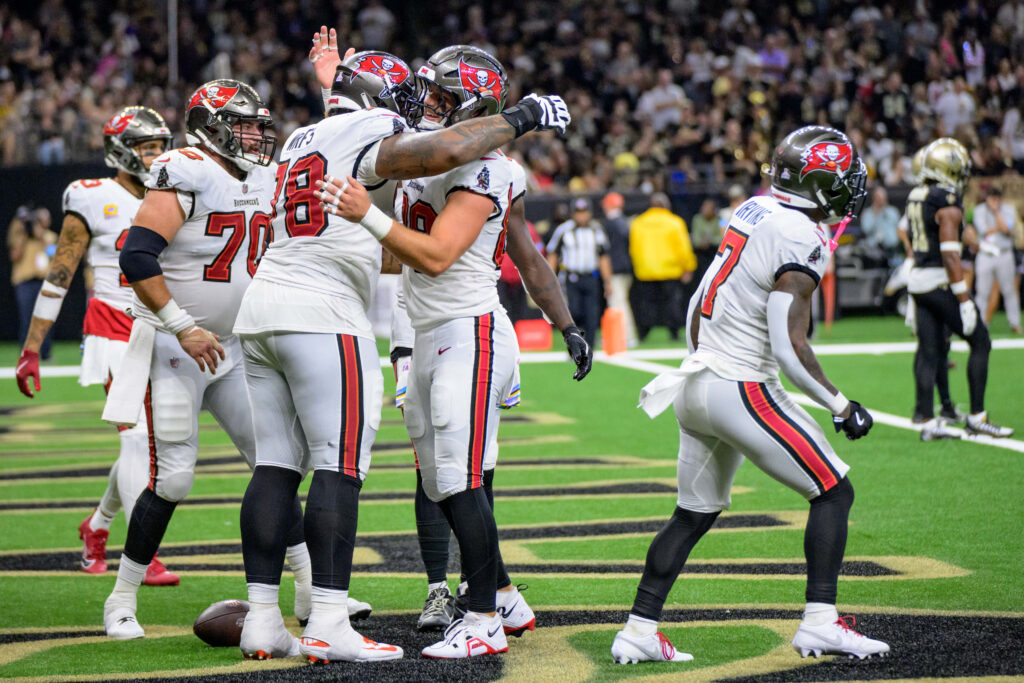
5. Buccaneers have enough answers to make up for mistakes
In one of the wildest games of the season, the Tampa Bay Buccaneers beat the Saints 51-27. All 27 of the Saints’ points came in the second quarter of Spence Rattler’s debut. Tampa Bay jumped out to a 17-0 lead, and then New Orleans eventually led 27-24 before the Buccaneers outscored the Saints 27-0 in the second half.
The Tampa Bay offense has been rolling during the past few weeks in wins and losses. The Bucs were finding ways for Baker Mayfield to get the ball out quickly and hit Chris Godwin and Mike Evans in the quick game.
That didn’t quite translate in Week 6, though Godwin still had plenty of opportunities and caught 11 passes for 125 yards and two touchdowns. He should partly thank the New Orleans defense for one of the worst displays of tackling this season.
With the Saints up 27-24 in the third quarter, this catch just beyond the line of scrimmage turned into a 55-yard touchdown.
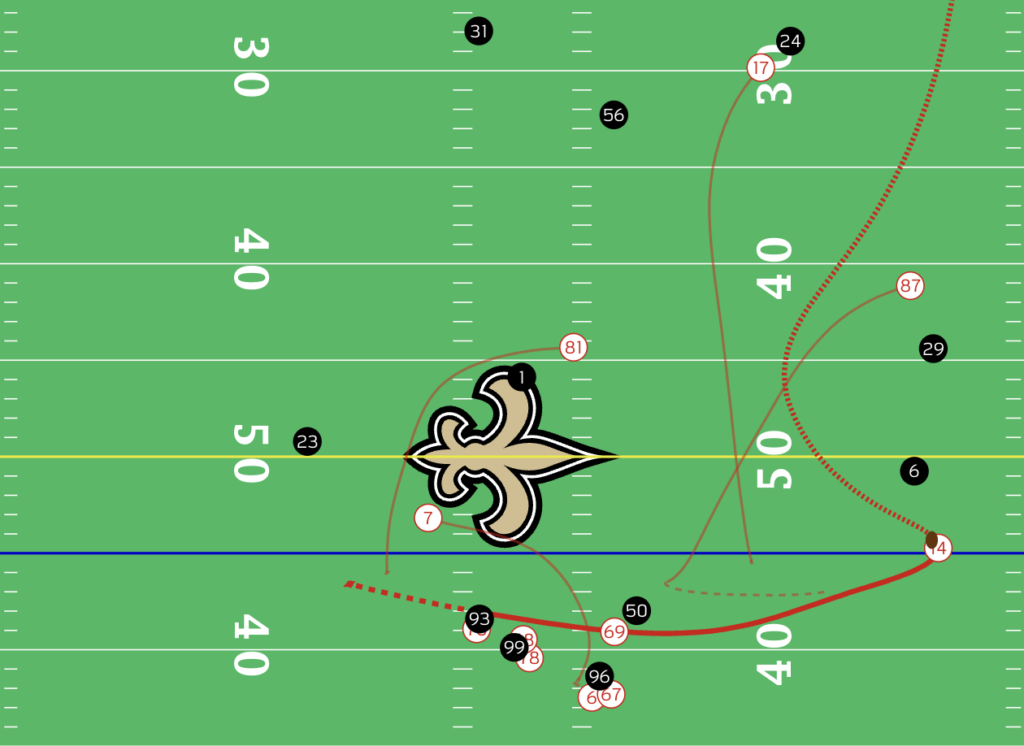
Mayfield turned back into a bit of a chaos agent with three interceptions and more extended plays — for better or worse — but he also threw four touchdowns and averaged 9.0 yards per attempt. He still finished the day with 0.31 EPA per play (seventh-best for the week) and a 52.5 percent success rate.
This was Mayfield’s seventh career game with three or more interceptions. It’s the first he’s won, with only one other outing eclipsing a 45 percent success rate.
That’s a fun thing about this Tampa Bay offense right now. There are so many good plays baked into the offense that it can make up for some of the negatives, even when those might be as bad as they can get.
One of the biggest developments was the running game, which saw two backs go off. Sean Tucker had 14 carries for 136 yards and a touchdown, while Bucky Irving had 14 carries for 81 yards and a touchdown. Tucker led the week in EPA on rushes and had a 71.4 percent success rate. The 2023 undrafted free agent had 17 career carries and 30 yards before this game.
Tampa Bay is now 4-2 but trails Atlanta in the NFC South because of a head-to-head loss last week. How good the Buccaneers are and how seriously they can contend will be tested in the next four weeks with games against the Ravens, Falcons, Chiefs, and the 49ers before a bye in Week 10.
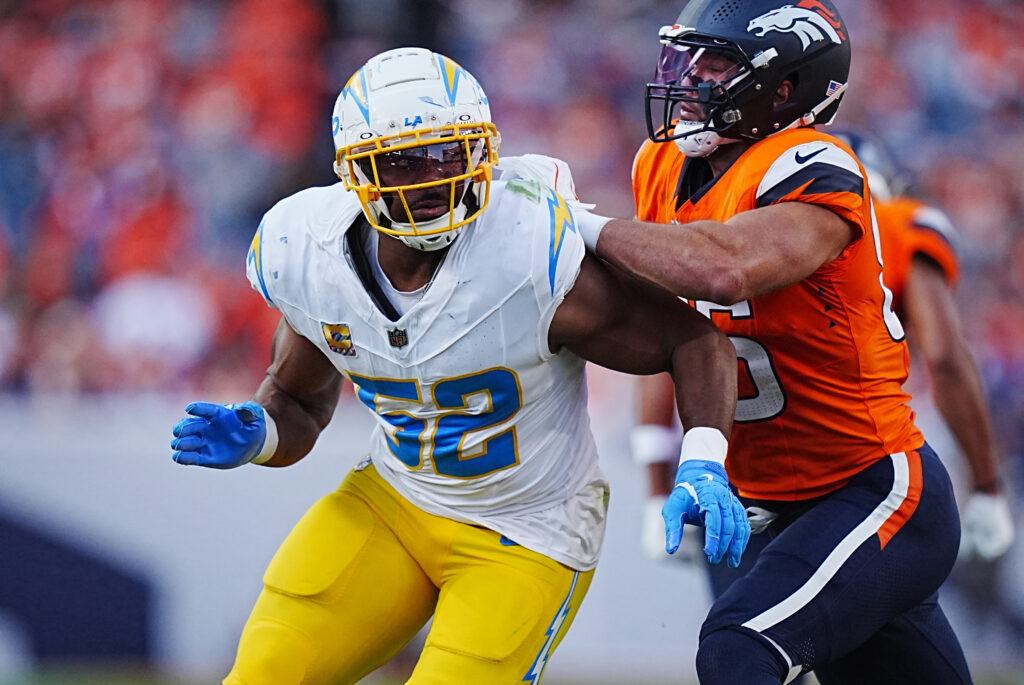
6. Chargers Defense Has Been An Overlooked Unit
The Los Angeles Chargers are second in defensive EPA per play and first in success rate. After a 23-16 win against the Denver Broncos, the Chargers are 3-2 and would be the sixth seed in the AFC if the playoffs started today.
To this point, the list of offenses the Chargers have faced has not been all that impressive. They played the Raiders, Panthers, Steelers, and Chiefs before the Week 5 bye. Per FTN, that had been the sixth-easiest slate of opponents for a defense so far. The Jaguars had the easiest, and they still had the league’s worst DVOA, so it’s not all about the schedule.
This Chargers defense is sound. Only the Jets (pending MNF) have allowed a lower rate of opponent drives to turn into touchdowns (12.7 percent), and only the Vikings have allowed a score on a lower percentage of drives (23.6 percent).
Just 16.4 percent of opposing drives against the Chargers have reached the red zone, the league's best rate.
A lot of this comes from an excellent run defense that ranks first by EPA per play. Ironically, the Chargers are defending the run well by using the highest rate of light boxes, allowing more players to sit back in coverage. The defense has allowed the fourth-fewest yards after the catch, per Next Gen Stats.
There has always been talent on this defense, and now it’s starting to come together, even if in mostly unspectacular ways.
The Chargers held the Broncos scoreless through three quarters before late touchdowns got Denver on the board. This defensive run could keep going. Next week, they have the Cardinals, followed by a Specer Rattler-led Saints and the Browns.
Having a successful and sound defense could be enough to get by while the offense gets healthier and works through fitting in its new players. It’s at least something to watch, as the quality of coaching is evident.
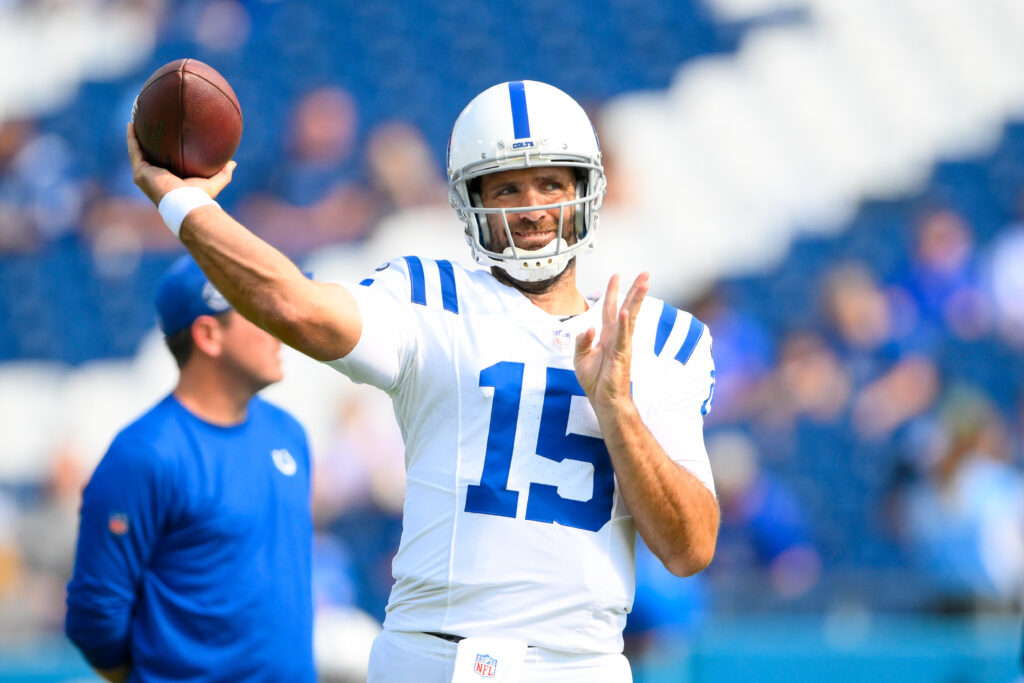
7. Is Flacco's Offense Better Than Richardson's?
Joe Flacco is a 1-1 starter for the Colts after a 20-17 win against the Titans. He also came in with a win in his first game when he replaced Anthony Richardson. Flacco is averaging 0.13 EPA per play and the offense has looked better with the veteran behind center. So, what’s going on, and is this a reason to worry about Richardson?
It doesn’t have to be. There’s a clear gap in where Flacco and Richardson have thrown the ball. Flacco has been more willing to take throws in the middle of the field, while Richardson was more deep and down the sideline.

Flacco (40.9 percent) and Richardson (40.2 percent) have nearly identical success rates, but where those successes have come make a difference.
In his appearances, Flacco has targeted crossers on 12 percent of his attempts, while that’s only 6.5 percent for Richardson. Meanwhile, Richardson has a 14.3 percent go-ball rate, while it’s 7.8 percent for Flacco. Flacco also has targeted slants on 7.4 percent of throws, while Richardson has yet to do so.
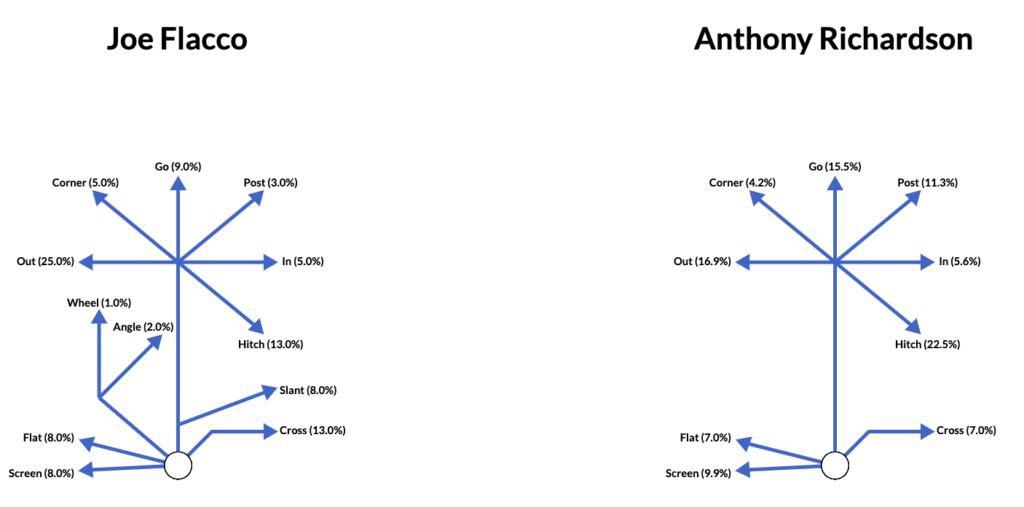
Those short middle-of-the-field throws can make a difference, especially with receivers like Josh Downs, who can take a pass like that for a long gain, or Michael Pittman Jr., who can box out smaller defenders.
Flacco's style of play should be a benefit for Richardson to see how making those throws can open up some of the deeper shots, where Richardson can thrive.
8. Chart of the day

Drake Maye was impressive but inconsistent in his first NFL start. He went 20-of-33 for 242 yards with three touchdowns and two interceptions. He averaged -0.42 EPA per play, but his 45.2 percent success rate is a slightly better picture of his day.
Maye was often under pressure behind New England’s offensive line and was hit eight times for 19 percent of his dropbacks, but he handled himself well in the pocket. Against the blitz, Maye went 6-of-9 for two touchdowns and one interception for 0.68 EPA per play and a 70 percent success rate that included an 11-yard scramble.
His three touchdowns already surpass Jacoby Brissett’s two on the season, and his deep touchdown to Kayshon Bouttee was the longest for a Patriots quarterback since 2022.
It wasn’t a perfect start, but Maye showed enough against a tough Houston opponent to be optimistic about his ability to handle himself in the Patriots situation and continue to grow and develop as a passer.
He gets a struggling Jaguars defense in London next week.
9. Play of the day
Tyler Allgeier ran over several Panthers as part of a 105-yard day on the ground.
Bijan Robinson added 95 yards and a touchdown. Allgeier and Robinson were third and fourth on the day in EPA gained on the ground. The Falcons, as a whole, had a 64.7 percent rushing success rate against Carolina in a 38-20 win.
10. Dynamic kickoff update
Thursday night featured the second kickoff retired for a touchdown this season. So, it’s a good time to check in on the dynamic kickoff.
Through six weeks, excluding Monday Night Football, 32.3 percent of kicks have been returned. The average starting field position overall, including touchbacks, is the 29.4-yard line, and the average starting field position after a kick return is the 28.1.
So far, 37.7 percent of kick returns have reached the 30-yard line, while there have been fewer completely stuffed runs, with only 11.9 percent stopped inside the 20-yard line. All of those numbers are well above what returns looked like last season when only 11 percent of kicks were returned.

Despite kick returns being relatively successful compared to touchbacks, kicking teams have not committed to sending the ball into the end zone. In fact, Week 6 featured the highest return rate of the season, with 41.8 percent of kicks returned.

Part of the Week 6 return rate was from some desperate teams trailing and trying to make something happen with a big return. The Cowboys returned four kicks from deep in their own end zone against the Lions but came out with returns of 79, 33, 33, and 49 yards.
The increased rate of returns in the past two weeks is something to monitor. They haven’t led to fewer returns passing the 30 or getting stuffed. In fact, the opposite is true. If return units are more willing to take the chance of running it out of the end zone in an attempt of a big return, we could be in for a fun rest of the season.


